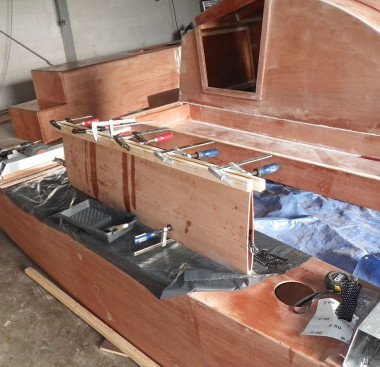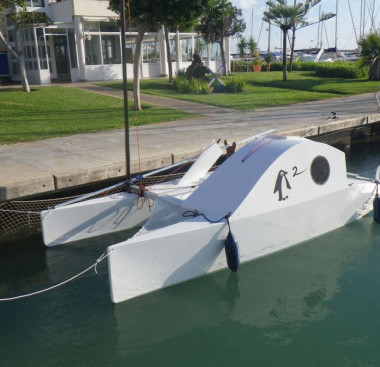CataProa - a micro multihull by Bernd Kohler
Modern multihulls got their start in the 1960’s by being relatively cheap and embarrassingly fast when compared to the monohull sailing yachts of the day, and so attracted an enthusiastic following of iconoclasts. Since then, multihulls have cruised relentlessly up market - leaving the “cheap” aspect in the wake of history. Bernd Kohler is one multihull designer and pioneer who still appreciates the virtue of thrift, and his online portfolio is full of innovative boat plans from 4.25m to 12.5m that really do provide excellent value for the dollar. His latest effort is an asymmetrical catamaran that he kindly shares with us here at Proa file.
A new idea and a new design is born: a micro-cruiser multihull for the lowest cost and work.
“I like proas but I do not like shunting. It is okay for long distances but not, for instance, on a narrow channel or river with a lot of traffic like we have here in the Netherlands. It takes too much time. So… perhaps a tacking proa? A moment please - a tacking proa sails on one tack as a Pacific proa (ama to windward) and on the other tack as an Atlantic proa (ama to lee). A small ama in respect to the main hull is not desirable when sailing on the Atlantic proa tack. A low volume ama can lead to a diving bow and even a pitchpole. The solution: make both hulls the same length and volume (to a given point). Next place the rig on the ama or “secondary” hull and you have a CATAPROA®.
“Here is the result. A one or two person boat for raids and treks. The cabin looks tiny from the outside but is adequate. The Cataproa is still a prototype, but I am busy refining the design. So far, the tests are showing the potential of the boat and I am very pleased. Most surprising is the handling quality, which is even better than expected. Coming about and gibing is like a very good dinghy. I can say nothing as yet about the speed potential - I have sailed the boat only in light winds. However, 5 knots boat speed in 6 knots of wind is not bad.
“To follow the low cost approach I have used a Sunfish sail and parts of the rigging. The windsurf mast you see in the photos was too weak, I changed to a carbon tube with a diameter of 50mm. Construction is the time proven plywood/glass/epoxy composite system. I stick with the system because it is the most cost efficient way to built a very light boat. Any other comparable system (like carbon/foam sandwich) would cost 4 to 5 times more. The construction is a mixture of systems. No “stitch and glue” (too time consuming when you look at the steps necessary). The hulls are taped together and then fillets and glass strips are added on the inside. The sheer line is conventionally built up with stringers. I built the boat in around 180 hours. A first time builder would of course require more time. The total weight of the boat including the rig is 89 kg. The mast hull weights a mere 22 kg.
“I built the boat for under € 1000 (currently $1,106), plus US $110 for the sail, and plus the cost of the mast. here I can give no estimate, because the price for carbon tubes vary depending on the country where they are purchased.
“To shift the pressure points (CLR) of the hulls to the correct position in relation to the CE of the sail from one tack to the other, the daggerboard is canted forwards and backwards. The system works to perfection.
“The only change I’ve made so far is to make the cockpit 100mm wider than the boat shown. Another update will be to make the boat foldable. At the time I was designing and building the boat I did not see how easily the boat can be made to fold for trailering. I didn’t bother to think about it, because I set up the boat on the trailer (fastening 8 bolts) then I lift the trailer and the boat slides in the water. Launch time in about 30 minutes, the reverse process is even faster, a big bonus of a light boat.
“For interested persons in the European Community, the boat is officially certified for coastal sailing.”
———-






A very interesting micro cruiser study! How much does the dagger board need to cant? What causes the shift in CLR on the two tacks? How do you cant it? How close winded is it?
I’d love to see some on-board footage of it sailing!